Bring Joy Back to Family Meals
(Family Features) While meals savored with loved ones are intended to produce smiles and shared moments, the process of grocery shopping, planning and cooking has become a chore for many families. Take the first step toward bringing back the joy and magic of making your favorite foods with tools that do the work for you.
For example, the all-in-one Albertsons Meal Plans and Recipes tool allows you to focus on what you want to eat rather than what you need to buy as it empowers everyday home cooks to plan, shop and prepare personalized recipes based on dietary preferences, allergies or family likes and dislikes. The app features a library of 9,000 exclusive recipes created by professional chefs (with new recipes added each month) and includes tasty dishes such as Sheet Pan Cajun Shrimp Fajitas with Bell Pepper, Onion and Spicy Ranch; Cheese Tortellini and Cauliflower with Creamy Spinach Marinara; and Garlic-Parmesan Chicken Tenders with Green Beans and Honey Mustard Dip.
The free digital tool also includes an artificial intelligence-powered “Scan Your Own Recipe” feature that allows you to snap a photo with your phone of grandma’s handwritten, not-so-secret recipe and transforms it into a digital version saved in the app. Recipes are instantly turned into shoppable ingredients and added to your cart for quick, convenient checkout. Now, you can turn all of your recipes into a digital library for quick and easy access in one place. No more flipping through cookbooks or recipe cards searching for your favorites.
Designed to provide culinary inspiration throughout the week while saving time and money, the app also features a budget tracker and hands-free cooking mode with a step-by-step timer.
“The Albertsons Meal Plans tool is the ultimate life hack,” said Jill Pavlovich, senior vice president of digital customer experience for Albertsons Cos. “This all-in-one app makes it simple for anyone to plan, shop and prepare inspiring recipes from anywhere – whether it is an old family favorite, a best-seller from a favorite food blogger or one of our 9,000 delicious recipes. Best of all, it’s completely free to use on our grocery app and website.”
The tool is available on the store apps and websites across the Albertsons Cos. banner of stores including Albertsons, Safeway, Vons, Jewel-Osco, Shaw’s, Acme, Tom Thumb, Randalls, United Supermarkets, Pavilions, Star Market, Haggen, Carrs, Kings Food Markets and Balducci’s Food Lovers Market.
Find more information and a seemingly endless collection of recipes at Albertsons.com.
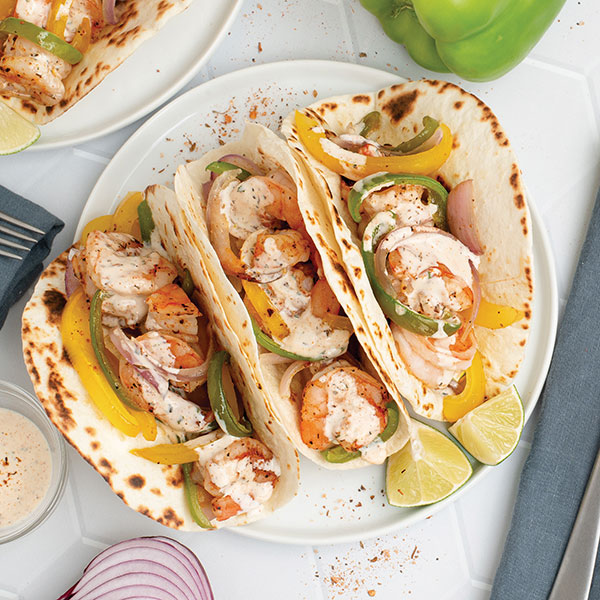
Sheet Pan Cajun Shrimp Fajitas with Bell Pepper, Onion and Spicy Ranch
Recipe courtesy of Albertsons
Total time: 30 minutes
Servings: 4
- 2 green bell peppers
- 2 yellow bell peppers
- 1 lime
- 1 medium red onion
- 2 tablespoons extra-virgin olive oil
- 1 1/2 pounds raw, peeled shrimp, fresh or frozen
- 5 teaspoons Cajun seasoning, divided
- 1 teaspoon salt
- 1/2cup ranch dressing
- 12 small flour tortillas
- Preheat oven to 450 F.
- Wash and dry green bell peppers, yellow bell peppers and lime.
- Trim, seed and slice bell peppers lengthwise into thin strips; transfer to large baking sheet.
- Peel, halve and slice onion lengthwise into thin pieces; add to baking sheet with bell peppers.
- Drizzle veggies with oil, toss to combine and spread in even layer. Bake until veggies have softened slightly, about 5 minutes.
- If using frozen shrimp, place them in colander and run under cold water to thaw slightly. Place shrimp on clean towel or paper towels and pat dry.
- Remove baking sheet from oven. Arrange shrimp over veggies then sprinkle with 4 teaspoons Cajun seasoning and salt; toss to combine and spread in even layer.
- Bake until veggies are tender and shrimp are cooked through, 5-7 minutes. Remove from oven.
- Cut lime into wedges.
- In small bowl, stir ranch dressing and remaining Cajun seasoning.
- Warm tortillas in skillet, oven or microwave, if desired.
- Divide tortillas between plates and fill with shrimp and veggies; drizzle with spicy ranch and serve with squeeze of lime.
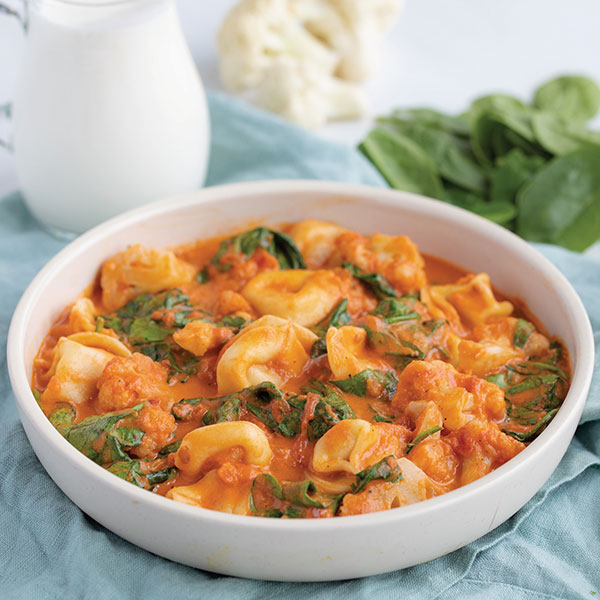
Cheese Tortellini and Cauliflower with Creamy Spinach Marinara
Recipe courtesy of Albertsons
Total time: 20 minutes
Servings: 4
- 2 bags (10 ounces each) cauliflower florets
- 18 ounces cheese tortellini, fresh or frozen
- 1/2 tablespoon salt
- 1 jar (24 ounces) marinara sauce
- 8 fluid ounces heavy whipping cream
- 1/2 teaspoon basil, dried
- 1/4 teaspoon black pepper
- 2 packages (5 ounces each) baby spinach
- Fill large pot halfway with hot water, cover and bring to boil. Uncover then add cauliflower, tortellini and salt; stir for a few seconds. Cook, stirring occasionally, until just tender, about 5 minutes, or cook according to package instructions.
- In separate large pot over medium heat, stir marinara sauce, cream, basil and black pepper to combine and bring sauce to simmer. Once simmering, reduce heat to medium-low and cook until slightly thickened, 3-4 minutes.
- Wash and dry spinach.
- When sauce has thickened, add spinach to pot in handfuls, waiting for spinach to wilt slightly before adding next handful. Remove from heat and cover to keep warm.
- When cauliflower and tortellini are done, drain and add to pot with creamy marinara sauce; stir to combine.
- To serve, divide pasta between plates or bowls.
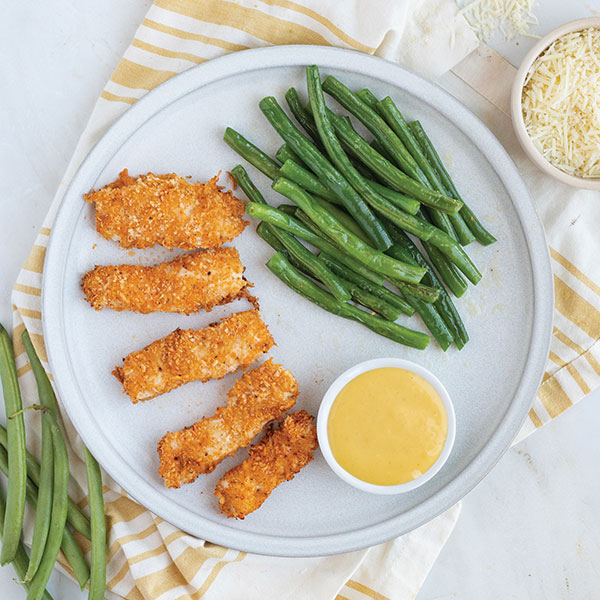
Garlic-Parmesan Chicken Tenders with Green Beans and Honey Mustard Dip
Recipe courtesy of Albertsons
Total time: 30 minutes
Servings: 4
- 2 tablespoons extra-virgin olive oil, divided
- 1/4 cup mayonnaise
- 1 teaspoon garlic powder
- 1 teaspoon salt, divided
- 2/3 cup Parmesan cheese, shredded
- 1/2 cup panko breadcrumbs
- 1/2 teaspoon paprika
- 1 1/2 pounds boneless, skinless chicken breasts
- 1 1/2 pounds green beans
- 1/2 cup honey mustard dressing
- Preheat oven to 450 F. Coat baking sheet with 2 teaspoons oil.
- In medium bowl, stir mayo, garlic powder and 1/2 teaspoon salt to combine.
- In separate medium bowl, stir Parmesan, breadcrumbs and paprika to combine.
- Pat chicken dry with paper towels and slice into 3/4-inch tenders. Add to bowl with mayo mixture and toss to coat.
- Working in batches, dredge tenders in breadcrumb coating, pressing to adhere. Transfer to baking sheet.
- Bake until tenders start to turn golden, about 10 minutes.
- On clean cutting board, wash, dry and trim green beans. Set aside.
- When chicken is golden, flip and bake until cooked through, 6-8 minutes. Remove from oven.
- Preheat large skillet over medium-high heat.
- Add remaining oil and swirl to coat bottom. Add green beans and remaining salt; cook, stirring occasionally, until tender-crisp, 4-5 minutes. Remove from heat.
- Divide chicken tenders and green beans between plates. Serve with dressing for dipping.
Source: Albertsons
Honey Mustard Crunch Salmon
(Family Features) Quick and easy family dinners often feel few and far between, but you can make them a more frequent occurrence by depending on seafood as a flavorful, easy-to-prepare protein.
Today, more than half of all seafood consumed in the U.S. is raised by aquaculture, also known as seafood farming. While this industry has made strides throughout the last few decades, from increasingly sustainable farming practices to technological advancements, not all seafood farms are equal and neither are the certifications you see on the packaging.
Aquaculture helps meet the ever-growing popularity of seafood and provides people in developing countries with healthy protein. It also aids in rebuilding populations of threatened and endangered species along with boosting wild stocks of freshwater and seawater species. By ensuring supply chain integrity from farm to the store, the Aquaculture Stewardship Council’s (ASC) Sea Green certification label lets shoppers know they’re protecting oceans, coasts and wildlife while also investing in restoring them.
With a mission to help the industry feed a growing global population while respecting the planet and its people, the council aims to minimize the industry’s impact on climate change and protect fish welfare. To achieve these goals, the certification label helps shoppers identify products that meet strict standards for responsibly farmed seafood, raising the bar for farm performance, verification and traceability.
With increased demand from the culinary community for alternative seafood sources that preserve wild populations without compromising farm-to-fork flavor or freshness, ASC’s certification helps ensure the seafood you’re buying is what it claims to be. That way, you can enjoy make-at-home recipes like Honey Mustard Crunch Salmon.
Visit SeaGreenBeGreen.org to find family-friendly recipes and certification information.
Watch video to see how to make this recipe!
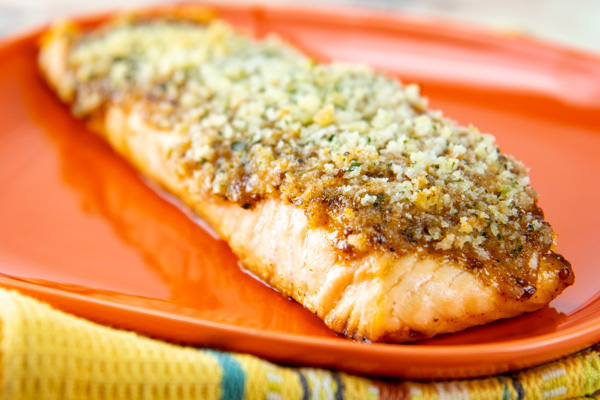
Honey Mustard Crunch Salmon
- 1 bag (1 pound, three 6-ounce portions) ASC-certified North Coast Seafoods Naked Norwegian Salmon
- salt, to taste
- pepper, to taste
Honey Mustard Glaze:
- 1/3 cup honey
- 1/4 cup whole-grain mustard
- 2 tablespoons smooth Dijon mustard
- 2 tablespoons mayonnaise
- 2 teaspoons horseradish
- 1 teaspoon smoked paprika
Crunch:
- 3/4 cup panko breadcrumbs
- 2 tablespoons dried parsley
- 2 tablespoons olive oil
- Thaw salmon and pat dry. Arrange on oiled baking tray. Season with salt and pepper, to taste.
- To make glaze: In small bowl, combine honey, mustard, Dijon mustard, mayonnaise, horseradish and paprika; mix until well combined. Chill glaze until ready to use.
- To make crunch: In bowl, combine breadcrumbs, parsley and oil; mix well. Reserve.
- Preheat oven to 400 F.
- Top each salmon portion with 1 tablespoon glaze and spread evenly over fish. Press crunch evenly onto glaze.
- Bake 15-17 minutes until fish is cooked through.
- Serve with drizzle of remaining glaze.
Source: Aquaculture Stewardship Council
Serve Flavorful, Sustainable Seafood
(Family Features) Whether seafood night at your house means sauteed shrimp, baked fish or anything in between, it’s an exciting excuse to bring the family together for favorite meals. Delicious recipes abound when seafood is on the menu.
However, this is no longer your grandparents’ seafood. Today, more than half of all seafood consumed in the U.S. is farm-raised – a practice known as aquaculture. While the industry has made strides throughout the last few decades, from increasingly sustainable farming practices to technological advancements that can help feed a growing population, not all farmed seafood is equal and neither are the certifications you see on its packaging.
For more than a decade, the global nonprofit Aquaculture Stewardship Council (ASC) has created and enforced the world’s strictest standards for farmed seafood. Its sea green ASC certification label is only found on farmed seafood that meets these high standards – helping seafood shoppers make informed purchasing decisions.
It’s a movement some of the nation’s leading seafood grocers and chefs are getting behind.
“About 2/3 of our seafood offerings are raised on farms, which reflects both growing supply and demand,” said Abe Ng, CEO of the Sushi Maki restaurant chain and market stations. “There’s a much broader customer understanding and appreciation of aquaculture than, say, 10 years ago. However, not all farmed seafood is equal in terms of quality, environmental sustainability and social responsibility.”
A unique combination of standards help ensure supply chain integrity from the farm to the store while protecting the environment, workers and communities. ASC’s sea green label only appears on seafood from farms that have been independently assessed and certified as environmentally and socially responsible.
“Whether your seafood is wild-caught or farmed, what matters to today’s shoppers is that it’s high-quality, flavorful and was fished or farmed in a responsible way that’s good for you and the planet,” said Roger O’Brien, president and CEO of the Santa Monica Seafood market and cafe. “Farm-raised seafood that’s been responsibly certified by the ASC delivers on the assurance that the seafood you’re buying is what it claims to be, which is a key commitment we make to our customers.”
With a trusted certification like the ASC, you can confidently enjoy make-at-home recipes like Honey Mustard Crunch Salmon, Blackened Shrimp Tacos with Creole Remoulade Slaw and Almond Stuffed Rainbow Trout without sacrificing taste or sustainability.
To find more certification information and discover family-friendly seafood recipes, visit SeaGreenBeGreen.org.
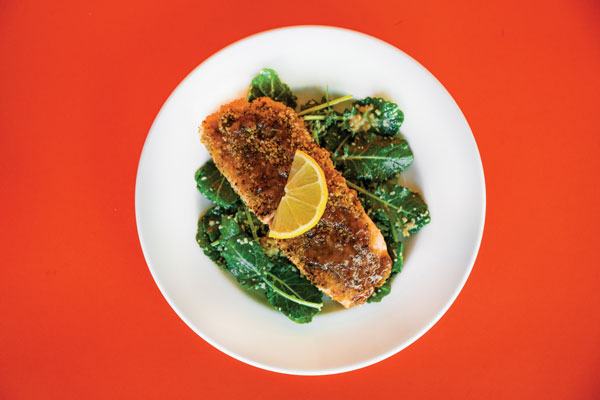
Honey Mustard Crunch Salmon
Recipe courtesy of North Coast Seafoods
- 1 bag (1 pound, three 6-ounce portions) North Coast Seafoods ASC-certified Naked Norwegian Salmon
- salt, to taste
- pepper, to taste
Honey Mustard Glaze:
- 1/3 cup honey
- 1/4 cup whole-grain mustard
- 2 tablespoons smooth Dijon mustard
- 2 tablespoons mayonnaise
- 2 teaspoons horseradish
- 1 teaspoon smoked paprika
Crunch:
- 3/4 cup panko breadcrumbs
- 2 tablespoons dried parsley
- 2 tablespoons olive oil
- Thaw salmon and pat dry. Arrange on oiled baking tray. Season with salt and pepper, to taste.
- To make glaze: In small bowl, combine honey, mustard, Dijon mustard, mayonnaise, horseradish and paprika; mix until well combined. Chill glaze until ready to use.
- To make crunch: In bowl, combine breadcrumbs, parsley and oil; mix well. Reserve.
- Preheat oven to 400 F.
- Top each salmon portion with 1 tablespoon glaze and spread evenly over fish. Press crunch evenly onto glaze.
- Bake 15-17 minutes until fish is cooked through.
- Serve with drizzle of remaining glaze.
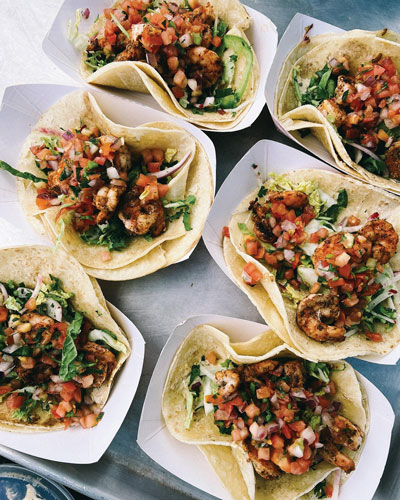
Blackened Shrimp Tacos with Creole Remoulade Slaw
Recipe courtesy of Coastal Seafoods and Fortune Fish & Gourmet
Prep time: 30 minutes
Cook time: 10 minutes
Coleslaw:
- 1/3 cup mayonnaise
- 1 tablespoon capers, chopped
- 1 teaspoon stone ground mustard
- 1/3 cup parsley, chopped
- 1/2 teaspoon horseradish
- 1/3 cup red onion, diced
- 1 tablespoon Cajun seasoning
- 1/2 bag coleslaw mix
Tacos:
- 6 small corn tortillas
- 1 tablespoon Cajun seasoning
- 1/2 pound peeled and deveined ASC-certified shrimp, thawed
- 3 green onions, sliced
- fresh salsa or pico de gallo (optional)
- 1 lime, sliced (optional)
- To make coleslaw: In bowl, mix mayonnaise, capers, mustard, parsley, horseradish, red onion and Cajun seasoning. Mix coleslaw and about 3/4 of dressing. Stir until coated then add more dressing, if desired. Refrigerate coleslaw until ready to serve.
- To make tacos: Heat grill to medium heat. Once hot, toast tortillas on each side until browned on edges. Stack toasted tortillas on plate and cover with towel until ready to serve.
- Pour Cajun seasoning over shrimp and stir until shrimp are coated.
- Cook shrimp 3-5 minutes per side, or until shrimp are firm and Cajun seasoning is blackened. Remove shrimp from grill to prevent overcooking.
- To serve, place about 1/4 cup coleslaw in each tortilla then top with 3-5 shrimp and green onions. Top with salsa or pico de gallo, if desired. Squeeze wedge of fresh lime over top, if desired.
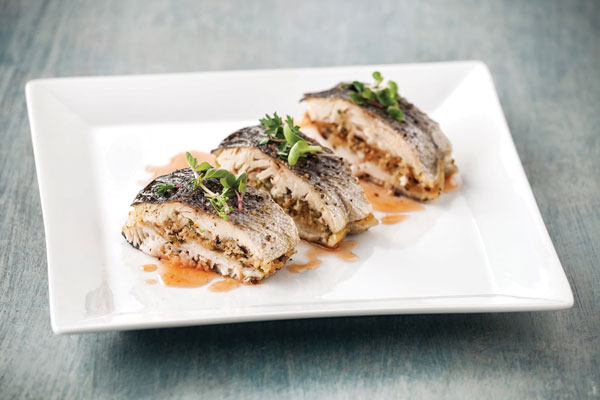
Almond Stuffed Rainbow Trout
Recipe courtesy of Riverence Provisions
- 2 ASC-certified Riverence Steelhead Trout fillets (8 ounces each)
- nonstick cooking spray
- 1/2 cup sliced almonds, toasted and coarsely chopped
- 2 tablespoons lemon zest
- 2 tablespoons lemon juice
- 1/4 cup chives, chopped
- 1 1/2 cups breadcrumbs
- 1/4 cup Italian parsley
- salt, to taste
- pepper, to taste
- 1 egg, beaten
- kitchen twine (6-inch lengths)
- 1 tablespoon olive oil
- Preheat oven to 350 F.
- Rinse steelhead trout fillets and pat dry with paper towel. Line baking pan with parchment paper and spray with nonstick cooking spray.
- Mix almonds, lemon zest, lemon juice, chives, breadcrumbs and parsley. Season with salt and pepper, to taste.
- Add beaten egg to breadcrumb mixture and stir until well incorporated.
- Lay first trout fillet skin side down on baking pan. Place twine pieces underneath fish, spacing 1 1/2 inches apart; leave untied.
- Place breading mixture over trout fillet and remaining trout fillet on top of breadcrumb mixture, skin side up.
- Secure trout fillets together using kitchen twine. Brush olive oil on trout and sprinkle with salt and pepper, to taste.
- Bake 15-20 minutes, or until fish is cooked through. Slice into portions to serve.
Source: Aquaculture Stewardship Council
How to Enjoy Fresh Maine Lobster this Season: Tips and tricks from a 4th-generation lobster family
(Family Features) As people look to change what’s on their plates, it can be tough to know where to begin. From social media-inspired recipes to trendy menu offerings, there are many options.
 That’s why restaurant owners Katie and Thom Werner are recommending a staple that’s sustainable, fresh and versatile: Lobster. The Werners own the popular Island Lobster Co. restaurant in Peaks Island, Maine where Thom works as a commercial fisherman and supplies most of the lobster served.
That’s why restaurant owners Katie and Thom Werner are recommending a staple that’s sustainable, fresh and versatile: Lobster. The Werners own the popular Island Lobster Co. restaurant in Peaks Island, Maine where Thom works as a commercial fisherman and supplies most of the lobster served.
The Werner family is well versed in the iconic Maine Lobster fishery, coming from a long line of generational fishing families, with Thom having fished since he was 6 years old. They know lobster can be intimidating for home cooks, but as people familiar with the product, they emphasize lobster is easy to prep, delicious and supports communities up and down the coast.
“Lobsters are always sustainably harvested and handled with care by the fishery,” Katie said. “It’s so important to know where your food comes from and with local lobster, it’s something you can feel great about enjoying that also directly benefits so many families like ours.”
For those looking to enjoy a simple and classic version of lobster, the Werners recommend a tried and true method.
“Steamed with some melted butter is always perfect,” Thom said. “You can’t beat the sweet, succulent flavors of fresh lobster with that punch of salty butter."
For those looking for a fresh twist, Katie suggests trying her favorite recipe at Island Lobster Co.: the BLT Lobster Roll.
“It’s a savory and sweet combination of crispy bacon, juicy tomatoes and tender lobster meat, all served on a buttery roll,” she said. “It’s a great way to enjoy sustainable trap-to-table fare.”
No matter what recipe people go with, the Werner family hopes everyone can partake in enjoying a staple of their heritage.
“To me, Maine Lobster is a taste of home,” Thom said. “I’ve always enjoyed it with friends and family. Now I get to share that legacy with my own kids and our community at the restaurant. I feel incredibly lucky, and I hope everyone – whether you’re a Mainer or on the opposite side of the country – can enjoy it as a celebration of such an iconic industry.”
To learn more about the Werners’ story, find recipes and look for ways to support the industry, visit lobsterfrommaine.com.
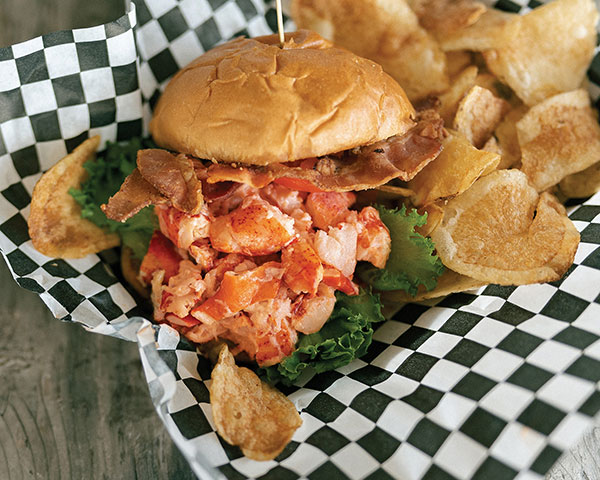
BLT Lobster Roll
Recipe courtesy of the Werner family of Island Lobster Co. on behalf of the Maine Lobster Marketing Collaborative
Yield: 1 roll
- 3 slices bacon
- 1/4 pound fresh lobster meat (or meat from 1-pound lobster)
- 1 tablespoon butter
- 1 brioche bun, halved
- 1 tablespoon mayonnaise
- 3 tomato slices
- 1 large leaf romaine lettuce or butter lettuce
- Preheat oven to 400 F. Line baking sheet with parchment paper and arrange bacon slices on top. Cook 10-15 minutes, or until desired crispiness.
- Prepare large pot with 2 inches of salted water and bring to rolling boil. Add lobster and steam 12 minutes. Halfway through, lift lid carefully and shift lobster to cook evenly.
- Break down lobster and remove meat from shell, yielding about 4 ounces of cooked meat. Chop meat into bite-size pieces.
- In large skillet or griddle over medium heat, warm butter to coat pan.
- Place both pieces of bun cut sides down on pan and cook about 30 seconds until golden. Remove buns from pan and set aside.
- In bowl, toss chopped lobster meat with mayonnaise and set aside.
- Assemble cooked bacon, tomato, lettuce and lobster mix on toasted bun.
5 Ways to Savor Fresh-Grilled Summer Seafood
(Family Features) Keep the grill cooking all summer long with a family favorite, seafood, and satisfy taste buds with fresh flavors hot off the grates. While some people assume seafood is challenging to cook, it can actually be an easy meal for home chefs of all skill levels.
To ensure your cookout is an unrivaled success, start with seafood that brings superior taste to the table. From crustaceans to a wide selection of unique-tasting oysters and sea scallops, mussels and clams, Maine Seafood offers something for all seafood lovers.
With a coastline that stretches 3,478 miles along the cold, clean North Atlantic, the state is home to a diversity of both wild-caught and farmed species.
Get inspired by these Maine Seafood grilling tips, sure to elevate your at-home seafood experience with the state’s superior taste and quality:
Littleneck Clams
Heat grill to medium-high heat then place littleneck clams directly on grill grates or in a single layer on a large baking pan. After 5-7 minutes on the grill, clams will begin to open. Without spilling juice, carefully place clams on a serving platter. Serve with melted butter or in pasta. Discard clams that don’t open.
Oysters
Place oysters cupped sides down directly on grill heated to medium-high. Cover the grill and cook until oysters open and meat is opaque and cooked through, about 5 minutes for smaller oysters and 8-10 minutes for larger ones. Place on a serving platter, remove top shells and run a sharp knife along insides of bottom shells to detach oysters. Top with garlic butter and serve with lemon.
Salmon
Heat grill to medium-high heat. Pat salmon dry; brush with olive oil and top with seasonings. Place salmon skin side down on grill grates and cook 6-8 minutes, or until meat turns opaque. You can also try a grill-safe cedar plank to infuse added flavor.
Haddock
Heat grill to medium-high heat. Pat haddock – flaky white fish that’s sweet and delicate – dry and brush with olive oil. Wrap fillets in aluminum foil with herbs and seasonings; completely seal with seam sides facing upward. Grill 8-10 minutes, or until meat turns opaque.
Lobster Tail
For a delicious twist this summer, enjoy these tender, tasty Grilled Lobster Tacos with vinegar slaw and cilantro lime crema.
For easy, delicious recipe inspiration and to order seafood straight to your door, visit SeafoodfromMaine.com.
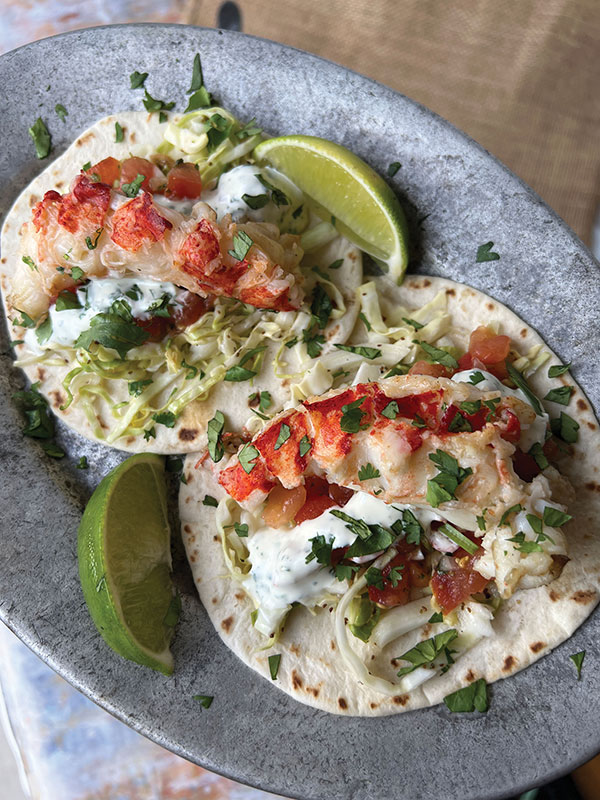
Grilled Maine Lobster Tacos
Total time: 25 minutes
Servings: 8
Vinegar Slaw:
- 2/3 cup apple cider vinegar
- 1 teaspoon celery seeds
- 2/3 cup white sugar
- 1 cup water
- 1/2 small head green cabbage, shredded or cut thinly (approximately 8 cups)
Cilantro Lime Crema:
- 1/2 cup sour cream
- fresh cilantro leaves, chopped
- 1/2 cup mayonnaise
- 4 teaspoons fresh lime juice
- 1 lime, zest only, minced
- 1/2 teaspoon minced garlic
- kosher salt, plus additional to taste, divided
- freshly ground black pepper, to taste
Lobster Tacos:
- Extra-virgin olive oil
- 4 large (4-6 ounces each) Maine Lobster tails, defrosted
- 4 tablespoons unsalted butter, melted
- salt, to taste
- pepper, to taste
- 8 small flour tortillas
- pico de gallo
- 1 lime, cut into wedges for serving
- To make vinegar slaw: In small saucepan over medium heat, heat apple cider vinegar, celery seeds, sugar and water; stir until sugar dissolves. In large bowl, pour mixture over cabbage; cover and refrigerate.
- To make cilantro lime crema: In blender, blend sour cream, cilantro, mayonnaise, lime juice, lime zest and garlic. Season with salt and pepper, to taste; refrigerate.
- To make lobster tacos: Preheat grill to medium-high heat.
- Brush grill grates with oil to prevent sticking. Using kitchen shears, cut lobster shells in half lengthwise. Place skewer through meat to prevent curling during cooking.
- Brush lobster meat with melted butter and season with salt and pepper.
- Grill lobster tails meat side down 5 minutes then flip.
- Brush meat again with butter and cook 5 minutes, or until opaque throughout. Cook to 140 F internal temperature.
- Remove meat from shells and cut into bite-sized chunks or leave whole, if desired.
- Place tortillas on grill 30-60 seconds per side, or until warmed and slightly brown.
- Add drained slaw to tortillas. Top with lobster meat, pico de gallo and cilantro sauce. Serve with lime wedges.
Source: Maine Seafood
Savor Spring Flavor with Fresh Seafood Recipes
(Family Features) Fresh, flavorful ingredients take springtime meals to another level, and it’s hard to top seafood as a seasonal favorite. Skip the wait at restaurants and instead create your own savory seafood dishes by taking advantage of easy-to-make recipes.
While takeout may be an easy option, the satisfaction of enjoying a delicious, home-cooked meal like Shrimp Pad Thai with Jasmine Rice can make you feel like you’re enjoying a restaurant-quality dinner. Next time you’re craving Asian cuisine, swap out traditional rice noodles for this version with Jasmine rice as an aromatic, quick-cooking solution for your own spin on a classic.
Take the guesswork out of cooking rice with an option like Success Boil-In-Bag Rice, which offers a heat safe, BPA-free and FDA-approved solution for fluffy, flavorful rice that cooks up perfectly. The high-quality grains are quick, easy, mess-free and ready in 10 minutes, so you can enjoy hassle-free dishes such as Successful Crab and Rice Cakes.
These crispy crab cakes come together easily and are served with a zesty, homemade aioli that tastes just like you’re on the coast. If you’re new to making crab cakes, it’s simpler than it may seem – just cook rice beforehand so it can cool then mix in beaten eggs, seafood and seasonings. Refrigerating and resting the mixture helps it hold together before frying to a mouthwatering golden brown for a delicious appetizer, snack or side dish.
Visit SuccessRice.com to find more springtime meal ideas.
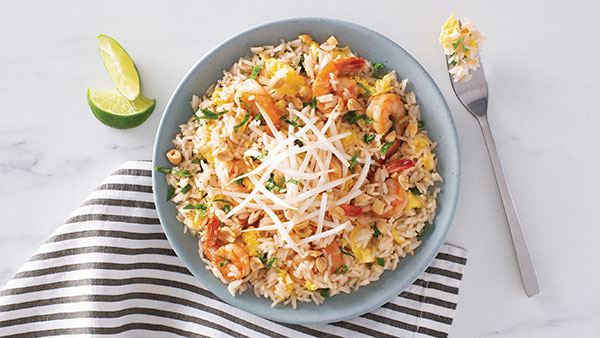
Shrimp Pad Thai with Jasmine Rice
Prep time: 15 minutes
Cook time: 10 minutes
Servings: 4
- 1 bag Success Jasmine Rice
- 3 tablespoons light brown sugar
- 2 tablespoons fish sauce
- 2 tablespoons lime juice
- 2 tablespoons soy sauce
- 1 tablespoon chili garlic sauce
- 2 tablespoons canola oil, divided
- 1 egg, lightly beaten
- 1 pound medium shrimp, peeled and deveined
- 1 tablespoon minced garlic
- 3 green onions, thinly sliced
- 1 cup bean sprouts
- 1/4 cup fresh cilantro leaves, chopped
- 2 tablespoons dry roasted peanuts, chopped
- 4 lime wedges
- Prepare rice according to package directions. Set aside.
- In small bowl, combine brown sugar, fish sauce, lime juice, soy sauce and chili garlic sauce. Set aside.
- In large wok or skillet over high heat, heat 1/2 tablespoon oil. Quickly scramble egg. Remove from pan and reserve.
- Add remaining oil to wok over high heat. Add shrimp and garlic; stir-fry 5 minutes, or until shrimp are cooked. Add reserved sauce and rice; stir-fry 2 minutes. Add green onions and reserved egg; toss to combine.
- Divide pad Thai between four bowls. Top each with bean sprouts, cilantro and peanuts. Serve with lime wedges.

Successful Crab and Rice Cakes
Prep time: 20 minutes
Cook time: 20 minutes
Servings: 4
Crab Cakes:
- 1 bag Success Brown Rice
- 2 eggs
- 1 pound lump crabmeat
- 2 tablespoons seafood seasoning
- 2 tablespoons olive oil
Aioli:
- 1/3 cup mayonnaise
- 1 teaspoon minced garlic
- 1 lemon, zest and juice only
- lemon wedges (optional)
- To make crab cakes: Prepare rice according to package directions. Allow to cool.
- In medium bowl, beat eggs lightly. Stir in rice, crabmeat and seafood seasoning; mix well. Refrigerate 5 minutes. Shape mixture into eight patties.
- In large, nonstick skillet over medium heat, heat oil. Working in batches, carefully place patties in skillet. Cook 5 minutes on each side, or until golden brown. Transfer to paper towel-lined plate.
- To make aioli: Stir together mayonnaise, garlic, lemon zest and lemon juice.
- Serve aioli with crab cakes and garnish with lemon wedges, if desired.
Source:
Light, Flavorful Meals to Beat Summer Heat
(Family Features) Hot days enjoying the summer sun are often best paired with meals that won’t drag you down, meaning lighter fare should be on your family’s menu. Skip the heavy recipes that leave you feeling uncomfortable and instead put a flaky, delicious option like wild salmon at the center of your plate.
Fresh, wild-caught California king salmon is available through mid-October, making it a perfect choice for satisfying warm weather dishes. Featuring tender, flaky meat with a rich, buttery flavor ideal for grilling, king salmon is also heart-healthy and packed with omega-3 fatty acids.
The fishery is managed responsibly to ensure there is never overfishing so you can feel good about the local, melt-in-your-mouth salmon. Plus, a portion of the commercial license fees are used to support habitat restoration projects, meaning money goes back to the fishery each time you enjoy it.
If it’s simply too hot to cook outdoors, Pan Seared Salmon with Cucumbers and Creme Fraiche offers a reprieve from the heat by putting your stovetop to work. Mix fresh cucumbers, red onion, dill and creme fraiche for a cool, creamy side then sear salmon seasoned with salt and pepper for a savory summer dish.
When you’re ready to head outside and fire up the grill, Cedar Plank Salmon with Miso Soy Glaze combines light, flaky salmon with a sweet homemade sauce to highlight the flavors of the season. Plus, it’s served right off cured cedar planks for an added touch.
Visit CalKingSalmon.org to find more recipes fit for light summer meals.
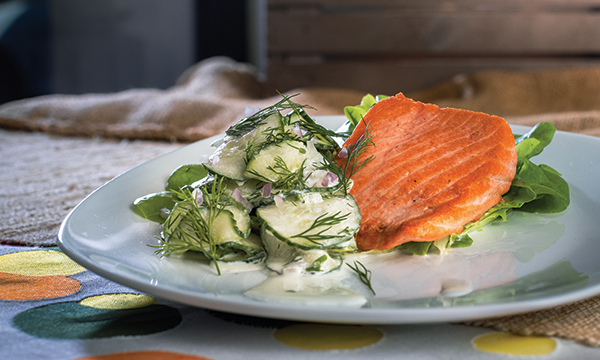
Pan Seared Salmon with Cucumbers and Creme Fraiche
Recipe courtesy of chef Laura Kenny, Real Food Catering, on behalf of the California Salmon Council
Servings: 4
Cucumbers and Creme Fraiche:
- 4 cucumbers, sliced 1/8-inch thick (about 4 cups)
- 1 small red onion, diced
- 2 tablespoons sea salt
- 2 tablespoons rice wine vinegar
- 1 tablespoon dill, chopped
- 1/4 cup creme fraiche
Pan Seared Salmon:
- 1 1/2 pounds salmon fillet
- salt, to taste
- pepper, to taste
- 3 tablespoons grapeseed oil
- To make cucumbers and creme fraiche: In medium plastic container or flat-bottomed bowl, place cucumbers in single layer then sprinkle in some red onion and some salt. Repeat 4-5 times until all cucumbers and onions are layered. Cover and refrigerate 2-8 hours. Drain water from cucumbers and onions by pressing firmly (do not rinse). Add vinegar and toss to combine.
- Just before serving, stir in dill and creme fraiche.
- To make pan seared salmon: Debone and cut salmon into four pieces; season lightly with salt and pepper, to taste. In large saute pan, heat grapeseed oil and sear salmon. When slightly golden-brown, flip salmon and cook just long enough to sear other side. Remove from pan and place on platter with cucumbers and creme fraiche.
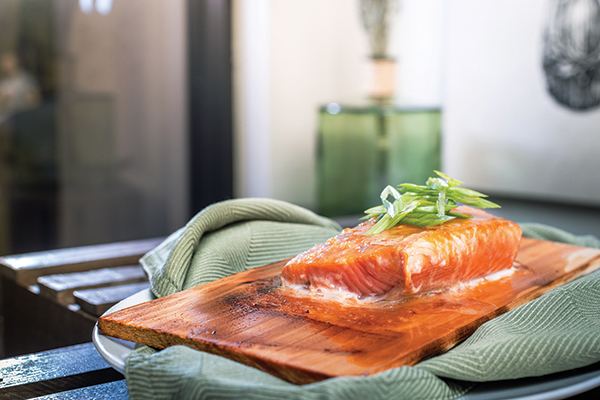
Cedar Plank Salmon with Miso Soy Glaze
Recipe courtesy of chef Laura Kenny, Real Food Catering, on behalf of the California Salmon Council
Servings: 2
- 2 cedar planks
- 2 teaspoons honey
- 1 tablespoon white miso
- 1 tablespoon rice wine vinegar
- 2 teaspoons soy sauce
- 1 garlic clove, minced
- 1 pound salmon fillet, skin on, cut into two pieces
- salt, to taste
- pepper, to taste
- To prepare cedar planks: Soak planks in water 1 hour. Heat oven to 375 F.
- Wash, oil and bake planks about 10 minutes to cure.
- Heat grill to medium-high heat for indirect grilling.
- In small bowl, mix honey, miso, rice vinegar, soy sauce and garlic. Cut salmon to fit planks. Season salmon with salt and pepper, to taste; spread miso mixture on flesh side. Let stand at room temperature 10-15 minutes.
- Lay salmon on planks skin side down. Place planks on grill adjacent to heat source and close lid. Cook 15-25 minutes, depending on thickness, until internal temperature reaches 125-135 F. Transfer salmon and planks to platter and serve.
Source: California King Salmon
5 Reasons to Add Lobster to Summer Meals
(Family Features) The arrival of summer means favorites like fresh seafood are back on the menu for many families. This year, as you explore new and inventive ways to add variety to weeknight dinners and backyard barbecues, consider including lobster as a versatile, indulgent ingredient.
Throughout the summer months, lobstermen up and down the Maine coast set off before dawn in pursuit of one of the most beloved crustaceans in the world. As one of the oldest fisheries in the country, the industry boasts a rich history with an unparalleled commitment to sustainability and environmental stewardship that has allowed it to thrive for generations.
In addition to its distinctly sweet flavor, consider these reasons to add Maine lobster to your menu this summer:
Sustainability
To help protect the lobster population and the livelihood of those in the fishery, the lobstermen pioneered sustainability and traceability practices before it was fashionable. The sustainability measures developed and adapted over generations, such as protecting egg-bearing females and releasing juvenile lobsters, have preserved the fishery and produced abundant lobster stocks.
Small Business Support
Unlike many commercial fisheries, the Maine Lobster industry consists of more than 5,000 independent lobstermen who own and operate small day boats. Many lobstermen are from multi-generational lobstering families, which, along with a mandatory apprenticeship program, ensure its continued survival.
Front Lines of Science
Mother Nature and science guide the fishery, meaning ongoing collaboration between scientists and fishermen to research the health of the lobster population and adapt to the effects of climate change to help protect the oceans.
Protection of Endangered Species
Sustainability for the industry means taking care of the larger marine environment and the species that rely on it. Since the 1990s, Maine lobstermen have taken proactive steps to protect endangered North Atlantic right whales by eliminating surface float rope, incorporating weak links to allow whales to break free in the event they encounter gear and marking rope to ensure traceability.
Community Engagement
The lobster industry goes well beyond the fishermen on the water; including the dealers, processors, restaurant owners, trap and boat builders and more. The fishery is part of the identity of Maine, which means enjoying lobster rolls, grilled tails or steamed lobsters this summer directly supports the community and the lobstermen who call it home.
To find more ways to support the industry and recipes to enjoy this summer, visit lobsterfrommaine.com.
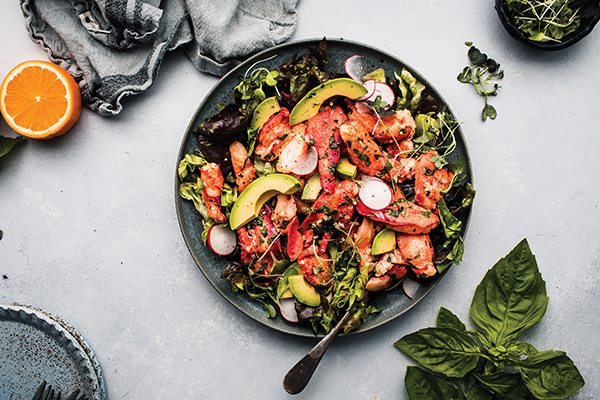
Chilled Lobster with Orange and Basil Vinaigrette
Recipe courtesy of Erin Lynch on behalf of the Maine Lobster Marketing Collaborative
Servings: 4
Dressing:
- 1 tablespoon minced shallots
- 2 tablespoons olive oil
- 2 tablespoons fresh orange juice
- 1 tablespoon fresh lime juice
- 2 tablespoons chopped fresh basil
- 1 tablespoon chopped fresh parsley
- 1/2 teaspoon salt, plus additional, to taste, divided
- 1/4 teaspoon Dijon mustard
- pepper, to taste
- 1 pound cooked Maine Lobster meat, cut into 1-inch pieces
- 1 head butter lettuce, torn
- 1 ripe avocado, peeled and diced
- 3 radishes, thinly sliced
- kosher salt
- freshly ground black pepper
- To make dressing: In medium bowl, whisk shallots, olive oil, orange juice, lime juice, basil, parsley, salt and Dijon mustard. Season with additional salt and pepper, to taste.
- Add lobster to bowl; toss to coat. Chill at least 1 hour, or up to one day.
- To serve: Arrange lettuce on serving plate and place lobster on top. Sprinkle with avocado, radishes, kosher salt and ground black pepper.
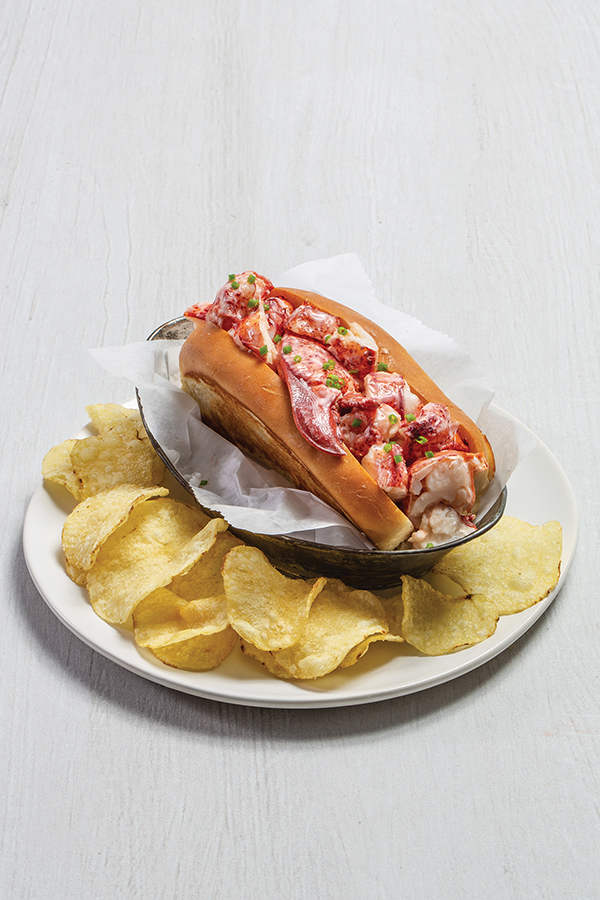
Traditional Lobster Rolls
Recipe courtesy of the Maine Lobster Marketing Collaborative
Yield: 4 rolls
- 1 pound cooked Maine lobster meat
- mayonnaise, to taste, for binding
- freshly ground black pepper, to taste
- salt, to taste
- fresh lemon juice, to taste
- 4 buttered, toasted rolls or preferred bread
- sliced chives, for garnish
- In bowl, combine lobster meat; mayonnaise, to taste; pepper, to taste; salt, to taste; and lemon juice, to taste.
- Place 3-4 ounces lobster salad on each roll.
- Garnish with chives and serve.
Put Sustainability on the Family Menu
(Family Features) Cooking delicious family meals is surely the focus of many home chefs, from quick dishes on busy weeknights to homestyle favorites on the weekend. Equally important, however, is dishing up foods and ingredients you can feel good about serving to your loved ones.
The next time seafood is on the menu, consider the source of your main course. Available fresh, frozen, smoked and canned year-round and nationwide, seafood from Alaska is sustainably harvested, and you can trust it comes from a responsibly managed fishery. Utilizing a science-based approach, the state sustains the long-term vitality of species and their natural habitats, as well as the fishing communities that rely on them.
Fishermen and scientists work together to ensure they only harvest what science tells them the ecosystem can support, so that fish stocks, communities and the marine environment can thrive for generations to come.
Wild, sustainable and harvested in the USA, Alaska seafood is full of flavor and high-quality protein, vitamins, minerals and oils essential to good health, including omega-3s and vitamin D. You can feel good serving your loved ones these Blackened Alaska Cod Tacos as a classic way to spice up your dinner table, or give a sweet heat kick to Spicy Alaska Sablefish in Lettuce Cups with Korean chili paste, miso and honey.
Visit alaskaseafood.org to find more information and family-friendly recipes.
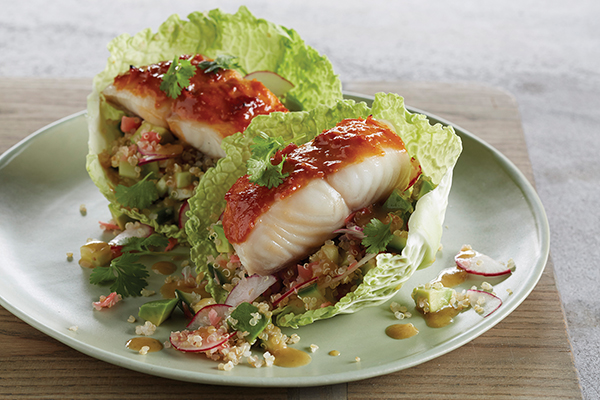
Spicy Alaska Sablefish in Lettuce Cups
Recipe courtesy of the Alaska Seafood Marketing Institute
Prep time: 20 minutes
Cook time: 10 minutes
Servings: 4 (2 lettuce cups each)
- 1/4 cup yellow or white miso
- 1 tablespoon Korean chili paste
- 1 tablespoon honey
- 1 pound Alaska sablefish (black cod), cut into 2-ounce portions
- nonstick cooking spray
- 1 small avocado, pitted, peeled and chopped
- 1-1 1/4 cups cooked sushi rice or quinoa
- 1/2 cup chopped English cucumber
- 1/4 cup thinly sliced halved radish
- 1/2 cup pickled ginger, chopped
- 1/2 cup bottled Asian-style salad dressing with wasabi and ginger
- 8 medium-large butter lettuce leaves
- 1/2 cup cilantro leaves
- Blend miso, chili paste and honey; spread onto Alaska sablefish portions. Place portions on nonstick cooking spray-coated, foil-lined baking sheet. Roast 5-7 minutes, or until fish is opaque throughout and deep golden brown; cool slightly.
- In mixing bowl, combine avocado, rice or quinoa, cucumber, radishes and ginger; pour in dressing. Toss to coat.
- To serve, place about 1/3 cup vegetable-rice mixture in each lettuce leaf. Top with one sablefish portion. Sprinkle each lettuce cup with 1 tablespoon cilantro leaves.
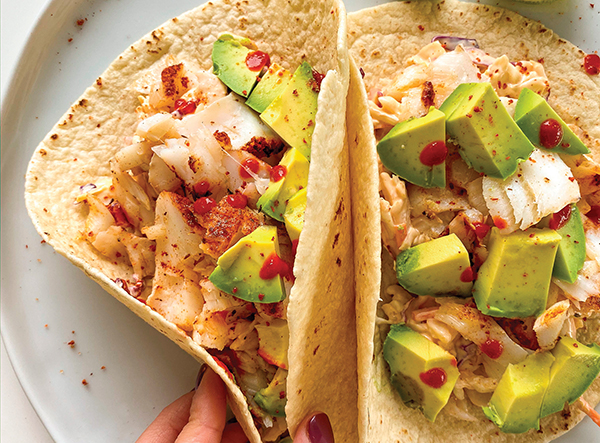
Blackened Alaska Cod Tacos
Recipe courtesy of the Alaska Seafood Marketing Institute and Sari Diskin
Prep time: 10 minutes
Cook time: 10 minutes
Servings: 2-3
- 2 cups slaw mix
- 2 tablespoons mayonnaise
- 1 teaspoon hot sauce, plus additional for serving
- 1 lime, divided
- salt, to taste
- pepper, to taste
- nonstick cooking spray
- 1/2 pound Alaska cod
- olive oil
- blackening seasoning, to taste, plus additional, divided
- sea salt, to taste
- 4 small flour tortillas
- 1 avocado, sliced
- Preheat oven to 400 F.
- In bowl, mix slaw with mayonnaise, hot sauce, juice from 1/2 lime and salt and pepper, to taste; set aside.
- Line baking dish with parchment paper and spray with nonstick cooking spray. Place Alaska cod on top and coat lightly with olive oil. Generously season with blackening seasoning and sea salt, to taste.
- Bake 5 minutes, set oven to broil and broil 3-5 minutes. When fish is done (when it flakes easily with fork and is opaque throughout), remove from oven and break into small chunks with fork.
- In flour tortillas, add avocado and slaw. Top with chunks of cod and drizzle with additional hot sauce, squeeze of lime juice from remaining 1/2 lime and additional blackening seasoning.
Photo courtesy of Sari Diskin (Blackened Alaska Cod Tacos)
6 Tips for Adding More Seafood to Your Family’s Menu
(Family Features) Seafood can make for a healthy addition to diets, particularly for children. It improves body and brain function, and studies conducted by “Pediatrics” and the “American Journal of Clinical Nutrition” have linked seafood to reduced risks of heart disease and allergic conditions like asthma.
In fact, the United States Department of Agriculture suggests making seafood part of healthy diets and its 2015-2020 Dietary Guidelines for Americans recommend putting it on menus at least twice a week.
While there are common complaints, such as “my kids won’t like it” or “I don’t know how to prepare it,” these tips can help make it quick, easy and affordable to add nutritious seafood to your family’s menu.
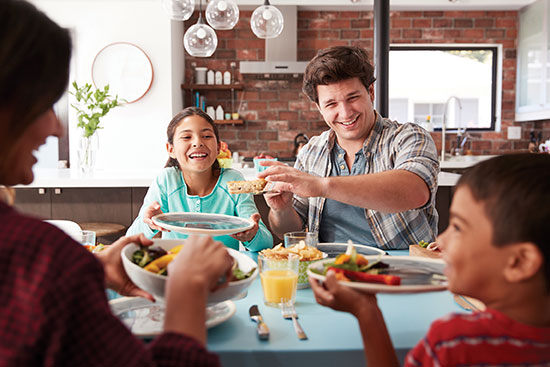
- Start with shrimp. Shrimp is one of the most popular types of seafood in the United States. Try shrimp warm or cold as a snack, appetizer or main course. It’s versatile and can be sauteed, broiled, boiled, grilled or baked.
- Make it fun. Consider putting healthy fish like wild cod, salmon or pollock into fun foods like tacos or burgers.
- Buy frozen. Fish is now flash frozen at sea to lock in freshness. Frozen seafood meals add convenience and help cut down on waste because what you don’t use can go back in the freezer.
- Cook with your kids. If your kids don’t think they like seafood, have them help with dinner. Cooking with kids can help develop healthier long-term habits and a more adventurous palate. It also helps improve motor functions and confidence. In fact, a study published in “Pediatrics” shows getting children involved in meal preparation may increase their enjoyment of healthy foods.
- Pick the right products. To create a family-friendly menu, consider an option like Aqua Star’s Cutting Board meal kits, a selection of 10 recipes that include everything a family needs to prepare a tasty, healthy meal. Selections include tacos, flatbreads and comfort favorites. With pre-portioned ingredients for quick preparation and cleanup, they make it easy for parents and kids to create their own restaurant-quality meals.
- Eat at home. Eating out often can drive unhealthy eating habits and strain family budgets. Seafood is easy and convenient to make, whether you use a simple recipe like these Chipotle Shrimp Street Tacos or choose a convenient meal kit, and can help you spend more time together at the dinner table.
Find more tips and recipes to add seafood to your family’s table at aquastar.com.

Chipotle Shrimp Street Tacos
Total time: 20 minutes
Servings: 2
- 1 Aqua Star Chipotle Shrimp Street Tacos Meal Kit, including:
- creamy ancho chili sauce
- Aqua Star shrimp
- chipotle seasoning
- spinach
- corn
- roasted tomato
- white corn tortillas
- 2 teaspoons cooking oil, divided
- Submerge unopened sauce packet in bowl of water to thaw.
- In large skillet, heat 1 teaspoon oil; add shrimp and cook 6-8 minutes. Drain excess fluid and add chipotle seasoning.
- In medium skillet, heat remaining oil; add spinach, corn and roasted tomato. Cook 4-5 minutes until water is evaporated; set aside.
- In microwave, warm tortillas in moist paper towel 30 seconds.
- To build tacos, fill two tortillas with shrimp and vegetables then top with sauce.
Photo courtesy of Getty Images (family eating)
Source: Aqua Star










